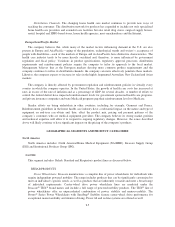Invacare 2009 Annual Report Download - page 21
Download and view the complete annual report
Please find page 21 of the 2009 Invacare annual report below. You can navigate through the pages in the report by either clicking on the pages listed below, or by using the keyword search tool below to find specific information within the annual report.FDA Form 483, which the company has addressed. In addition, Health Canada conducted an inspection of
Invacare's Kirkland, Quebec production facility with no major findings. Lastly, the quality management system
of all locations required to meet ISO 13485 requirements for Canada, Europe and other foreign markets were
inspected by a third party, quality system registrar during 2008 and/or 2009. All facilities were found to be in
compliance and were issued new quality system certificates.
From time to time, the company may undertake voluntary recalls or field corrective actions of the
company’s products to maintain ongoing customer relationships and to enhance the company’s reputation for
adhering to high standards of quality and safety. None of the company’s actions has been classified by the FDA
as high risk (Class I). The company continues to strengthen its programs to better ensure compliance with
applicable regulations and actively keeps abreast of proposed regulations, particularly those which could have a
material adverse effect on the company.
The company occasionally sponsors clinical studies, usually involving its respiratory products. These
studies have historically been non-significant risk studies with human subjects. Such studies, their protocols,
participant criteria and all results are registered in the Clinical Registry managed by the National Institutes of
Health and available to the public via the Internet.
Although there are a number of reimbursement related issues in most of the countries in which Invacare
competes, the issues of primary importance are currently in the United States. There are two critical
reimbursement issues for the company: the Centers for Medicare and Medicaid Services (CMS) implementation
of National Competitive Bidding (NCB) which Congress delayed in July 2008 and is currently scheduled to be
implemented January 2011 and changes to Medicare reimbursement payments for home oxygen mandated by the
Deficit Reduction Act.
Effective January, 2009, CMS imposed Medicare reimbursement cuts of 9.5% for those product categories
which had been included in phase one of the otherwise delayed NCB program. CMS has accepted bids from
home medical equipment providers for the NCB program which is scheduled to begin in January 2011 in nine
large metropolitan areas in the U.S. Contractors and bid prices are expected to be announced later this year, so
further delays are unlikely.
In addition to the 9.5% reduction in oxygen reimbursement from Medicare, the Deficit Reduction Act’s
thirty-six month limit on rental payments for home oxygen went into effect January 1, 2009. CMS has clarified
that payments do restart after sixty months of a patient’s usage of oxygen.
Although these reductions in Medicare payments are not beneficial to the home care industry, the company
believes that it can still grow and thrive in this environment. No significant cost-of-living adjustments have been
made over the last few years to the reimbursement and payment amounts permitted under Medicare with respect
to the company’s products, but the company will continue to try to respond with improved productivity to
address the lack of support from Congress. In addition, the company’s respiratory products (for example, the
low-cost HomeFill®oxygen delivery system) can help offset the Medicare reimbursement cuts to the home care
provider. The company will continue to focus on developing products that help the provider improve
profitability. Additionally, the company continues to focus on low-cost country sourcing and/or manufacturing to
help ensure that the company is one of the lowest cost manufacturers and distributors to the home care provider.
The U.S. Senate and the U.S. House of Representatives each recently passed health care reform legislation
that includes a new tax on medical device manufacturers, such as the company. The Senate version of health care
reform would impose a yearly sales-based tax on medical device manufacturers intended to raise $2 billion in tax
revenue annually beginning in 2011, and $3 billion in annual tax revenue beginning in 2017. The tax would not
be deductible by the manufacturer and the amount of tax payable by a manufacturer would be determined based
on market-share. The company continues to actively lobby members of Congress in an effort to make the
proposed legislation less onerous on medical device manufacturers, and, until the legislation is finalized, there
can be no assurance that the tax may not be eliminated, modified or delayed.
I-15
























